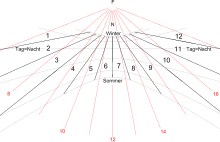
Back Hora temporània Catalan Temporale Stunden German Hora temporaria Spanish Heure temporaire French
This article needs additional citations for verification. (January 2023) |

Unequal hours are the division of the daytime and the nighttime into 12 sections each, whatever the season. They are also called temporal hours, seasonal hours, biblical or Jewish hours, as well as ancient or Roman hours (Latin: horae temporales). They are unequal duration periods of time because days are longer and nights shorter in summer than in winter. Their use in everyday life was replaced in the late Middle Ages by the now common ones of equal duration.
The first temporal hour of daylight begins at sunrise, the first of night at sunset. For example, if daylight and night are each divided into twelve temporal hours, midday and midnight are each the beginning of the seventh hour.
A clock that displays the temporal hours is called a temporal clock.